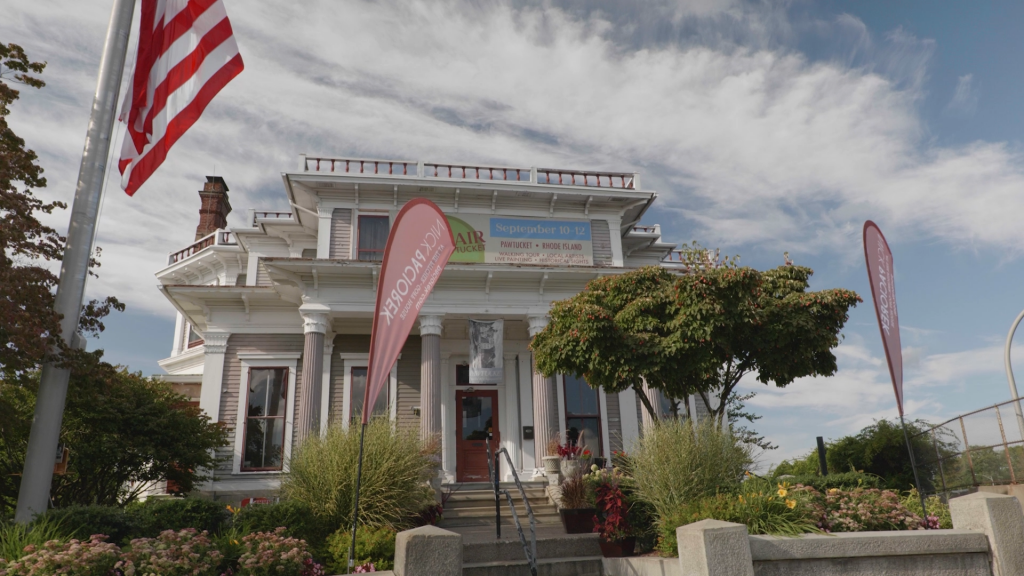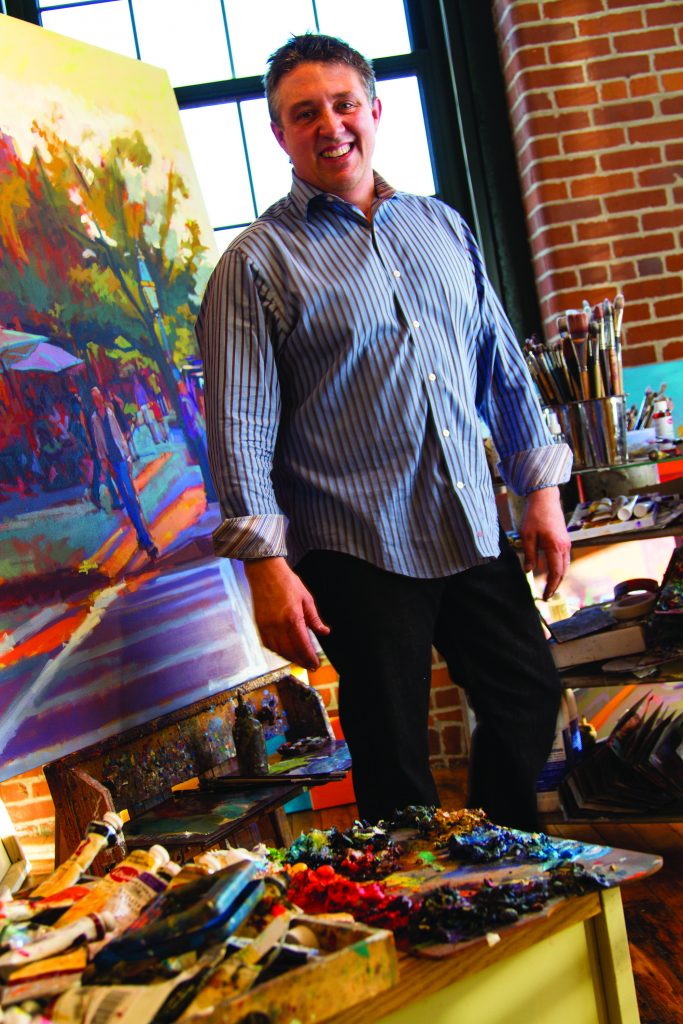Living the artist’s life means different things to every artist, but no matter your medium, it boils down to finding the time, space, and community to be able to focus on your art and hone your talent. But you don’t have to run away to an unheated garret in Paris to do it. Artist Nick Paciorek has created a unique way for emerging artists to immerse themselves in a singular creative experience, right in Pawtucket, Rhode Island.
Called The Artist Life Residency program, it’s a week-long experience at The Pitcher-Goff House’s Container Project – a courtyard of renovated shipping containers turned into mini studios. It’s open to all in the creative arts field – painters, writers, sculptors, photographers, musicians – who want to advance their skills and amplify their creative process. The program runs Monday through Friday from 8 a.m. to 5 p.m. and is geared toward those seeking a change of scenery to discover or fine-tune their artistic vision.

In this space, all residents will be able to discover new ways to create under Paciorek’s guidance. Each will have their own mini-studio space to work out of and a courtyard in which to gather and discuss ideas with others, whether about process, tools, the business, or their muse. “It’s complete artistic freedom,” Paciorek explains. “I don’t want people to worry about getting paint on the floor, or about the phone ringing. Just focus on their art.”
Artists will have access to the main house, home to Paciorek’s studio, and a captivating private gallery collection by established and emerging artists. Artists will also have access to the main house’s kitchen, bathrooms, and veranda.
Paciorek created the program to share his experience with others. “I always dreamed of being an artist since I was five. I’m very grateful my artist’s dream came true, and I want others to be able to experience it. As artists, each person is a little different in their daily routine, but we all need a support group. Part of the artist’s life is that you want to be around other artists, like me, because we each have different perspectives. I’m going to bring ideas and we’re going to have open discussions. If I hear music playing, I have an opinion where it takes me, how it feels. If I read a book, there are images that it produces. If I look at a painting or sculpture, the same thing. Because I’ve been doing this professionally for so many years, I’m able to help people find their direction.”
Another valuable aspect of The Artist Life Residency will be discussions focused on the business of art and various financial models: selling retail versus wholesale and selling through galleries or direct. It’s an aspect many budding artists don’t spend a lot of time on but in which Paciorek has a lifetime of experience. “You can have the greatest art in the world, but it doesn’t sell itself. It takes a lot of work to complete a sale – people to run the credit cards, hang the art, ship the purchases, market the show. That’s where galleries come in, and that’s where they earn their commission.”
HISTORIC, INSPIRATIONAL PAWTUCKET
Not only is the location convenient to the Boston-New York travel corridor, it offers a host of inspiration and historic architecture. Start with the historic Pitcher-Goff house itself, with prized architectural details and unique place in Pawtucket’s cultural heritage. Now on the National Register of Historic Places, the house was originally built for Elias B. Pitcher, a cotton textile manufacturer, in 1840 with a largely Italianate exterior and a Late Victorian interior. Later it was sold to Lyman B. Goff, another local industrialist, who made significant alterations to the interior, replacing a great deal of the older woodwork with more fashionable Queen Anne styling in 1881. Goff’s daughter donated the house for use by American Red Cross in 1922, and it has since served as a headquarters for the Boy Scouts, and as the Rhode Island Children’s Museum. Paciorek purchased it in 2020 and has begun a painstaking renovation to restore the home to its original beauty.
Located on a hilltop overlooking the Pawtucket River, the location offers a wide-ranging visual buffet from the beautiful grounds to the river just steps away. Pawtucket was the birthplace of the Industrial Revolution and there’s history around every corner with Rhode Island’s first national park, Pawtucket Falls, the Pawtucket library, and the Blackstone River. It’s home to the Slater Mill, where young industrialist Samuel Slater tapped the hydropower of both the Blackstone River and Pawtucket Falls, and for the first time in this country, cotton thread was spun by machine instead of by hand, changing the textile world forever. Slater Mill was the very first property to be named a National Historic place in 1966, launching the Preservation movement in the United States.
Pawtucket itself is known as an art and cultural center and is home to the annual Pawtucket Art Festival held each fall. The community features art studios and artists in every form, such as printmakers, glass blowers, silversmiths, visual artists, graphic designers, leather workers, jewelry designers, photographers, screen printers, dance studios and others. It also hosts a vibrant restaurant scene and the Stone Soup Coffeehouse, one of New England’s oldest coffee houses.
THIS ARTIST’S JOURNEY
Paciorek understands the artistic experience of finding your vision or voice on a deep level. Chicago shaped young Paciorek’s world and education brought him to Baltimore and Washington, D.C. as he explored his vision. He earned his BFA from the Maryland Institute College of Art and at his senior show he was fortunate to be picked up by Jerry Eisley at the Fox Hall Gallery in D.C. before graduation.

As an artist, Paciorek aligns himself with a new generation of Fauvists. Known for his vibrant cityscapes, he has traveled the world – from Italy’s Dolomites to France’s canals to Macy’s Thanksgiving Parade in search of inspiration, light and pattern. Early in his career, an art critic called him the Mad Beast of Color in terms of how he applies color, and the name stuck.
“A painter takes you on a tour through a painting by the use of color – you’re able to see different colors, different shades, different tones, and you’re able to guide a viewer to a certain point,” he explained. That focus on color and light brought him to where he is today: a renowned artist whose work is seen around the world.
But it wasn’t always easy and Paciorek said the 2007-08 recession was the best thing that ever happened to his career. “The recession forced me to do marketing that I hadn’t done before and try find new markets. I got involved in Artexpo New York, started to work both the retail and wholesale markets. The artist’s life is not an easy one – I’ve had to deal with things like my studio burning down. So where do you go from there? You have to be willing to go through the highs and the lows and move forward in a positive way.”

His career picked up steam and he began selling in more and more galleries from coast to coast and around the world. From 2014-2019 he ran ArtProv in Providence’s Jewelry District with his wife, artist Michele Aucoin, to share their passion and inspiration for art. His recent purchase of the Pitcher-Goff house enables him to fuse art, work, and home life in one place. All of these experiences inform the direction he brings to The Artist Life.
For all the program details, visit paciorek.com/the-artist-life. “You’re going to find your vision here.”
Author bio: Diane M. Sterrett is a versatile content provider with 30 years of experience and a passion for finding precisely the right words for every situation: magazine features, web content, blogs, advertising, direct mail, outdoor, brochures, trade publication articles, as well as eblasts and social media posts. She is passionate about learning and writing about the ocean, the environment, healthcare, and the art world. Based in Tiverton, RI, when not writing she can be found sailing Narragansett Bay and beyond.
Artist bio: As an artist, Paciorek aligns himself with a new generation of Fauvists. Known for his vibrant cityscapes, he has traveled the world – from Italy’s Dolomites to France’s canals to Macy’s Thanksgiving Parade in search of inspiration, light and pattern. Early in his career, an art critic called him the Mad Beast of Color in terms of how he applies color, and the name stuck.


